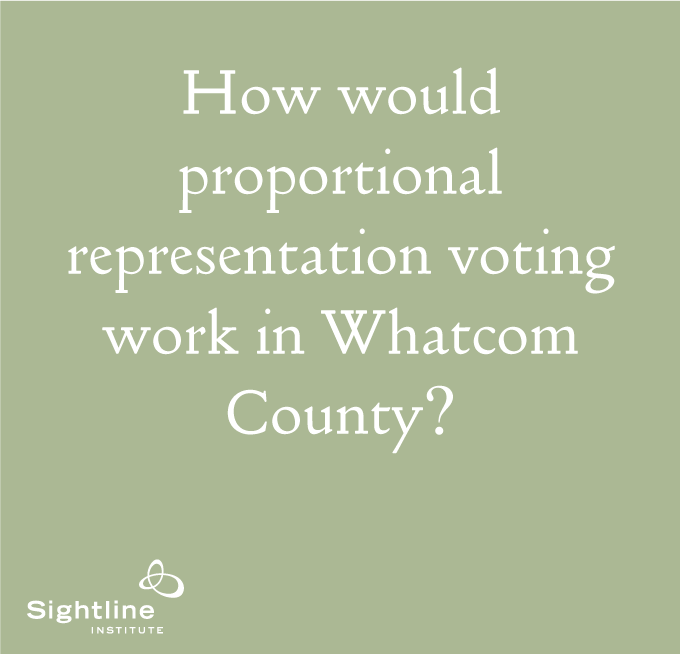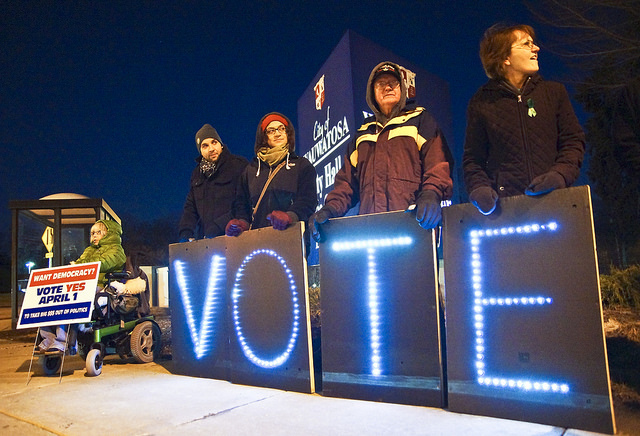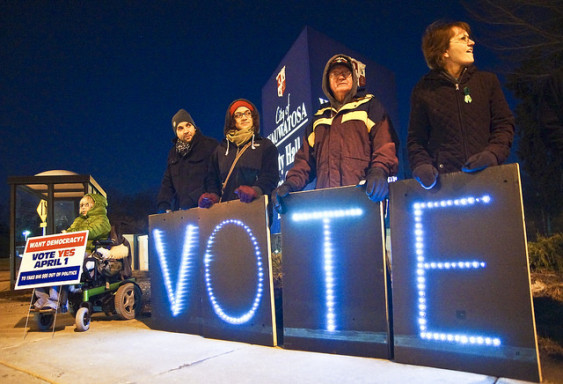Last time, I explained how the rise of independent voters and the popularity of party outsiders Sanders and Trump show that American voters want more options, and how the path to change in the United States is through the individual states themselves. Here, I describe a few ways Oregon and Washington could do what New Zealand did: switch from winner-take-all voting to proportional representation voting. By making the switch, Oregon and Washington could spark a movement towards proportional representation in federal elections, too.
Different paths lead to proportional representation. Below are a few configurations, of many possible variations, that Oregon and Washington could consider.
Oregon House: Ranked-choice voting
Article II, Section 16 of Oregon’s Constitution specifically authorizes proportional representation through ranked-choice voting (however, the legislature would have to change election law to implement it). With ranked-choice voting, voters aren’t limited to marking one box for one candidate, but instead are free to express their preference for their first, second, and third (or more) choices by ranking their candidates in order. In single-winner races, like Governor or Mayor, ranked-choice voting is often called Instant Runoff Voting (IRV) because a single ballot simulates a runoff by letting voters indicate who they would vote for in a runoff if their first choice had been eliminated.
In multi-winner races like legislatures or city councils, ranked-choice voting is called Single-Transferable Vote (STV) because voters have just one vote, but their vote can get reassigned to their second choice if their first choice is eliminated or has surplus votes. Legislative candidates run in multi-winner districts, and the top vote-getters in each district win seats. In a three-member district with ranked-choice voting, a third-party candidate can win a seat if more than a quarter of voters support her. Winner-take-all voting makes a third-party candidate with such strong support a spoiler, not a winner.
The Australian Senate, Ireland, Cambridge, Massachusetts, City Council, and other place use STV to achieve proportional representation. Here is an example of a hypothetical ranked-choice ballot for four councilors in Whatcom County:

Original Sightline Institute graphic, available under our free use policy.
And here’s how Oregon could adopt ranked-choice proportional representation for the state legislature:
- A 90-member single-chamber legislature: Combine the 60-member state House and 30-member state Senate to create one 90-member unicameral legislature, like Nebraska has had for almost 100 years. (The Republican who pushed for a single legislature in Nebraska reasoned that the two-house system was outdated, inefficient, and unnecessary. It made no sense, he said, for two bodies of elected officials to do the same thing twice.)
- 30 districts, with 3 representatives per district: Each of 30 legislative districts (the current Senate districts would suffice) elects three legislators to the new, single-chamber legislature. District representatives speak for the interests of their geographic areas and the values of their preferred party or parties.
- Ranked-choice open primaries: All candidates for the three district seats run against each other in a single pool in each district. In the open primary, voters rank candidates in order of preference, regardless of the voter’s party affiliation. The top six vote-getters in each district advance to the general.
- Ranked-choice general elections: In the general, voters rank the six district candidates in order of preference. The top three vote-getters in each district win seats.
- Who wins: The three candidates with the most votes win the three district seats. Each district would likely send representatives from at least two different parties to Salem. Third-party candidates with sufficient support would win, and unusual candidates, such as rural progressives and urban conservatives, could also win seats, creating bridges and alliances across parties. Voters of all stripes would likely have at least one district representative who reflects their political views.
For example, metropolitan Portland districts might elect a Democrat, a Working Families Party candidate, and a Republican. Rural Oregon districts might elect a Republican, an Independent, and a Democrat. Or two Republicans and one Democrat. Ranked-choice voting would empower voters to choose their real favorite—even a third-party candidate—without fear of throwing their vote away; if their favorite candidate gets eliminated, their vote is not wasted. Rather, it gets reassigned to their second-choice candidate. Ranked-choice voting could open up new avenues for deal-making in the legislature, too, as members of the Independent Party and the Working Families Party win seats alongside Democrats and Republicans, and as legislators from the same district but different parties work together to represent their diverse constituents.
Oregon: Mixed-member proportional voting
Several countries, including Bolivia, Germany, New Zealand, Scotland, and Wales, use Mixed Member Proportional (MMP) voting, and Canada is considering it. MMP, a hybrid system, might be attractive to former winner-take-all countries such as New Zealand, Scotland, Wales, and Canada, because it retains the familiar winner-take-all vote and adds a party list vote to reach an overall proportional legislature. Each voter gets two votes: one for her favorite candidate, regardless of party, and one for her favorite party. Here is an example of an MMP ballot:
 And here’s how Oregon might do it:
And here’s how Oregon might do it:
- A 50-member single-chamber legislature: Combine the 60-member state House and 30-member state Senate, and reduce the number of members to create one 50-member legislature.
- 30 districts, with 1 representative per district: Each of 30 legislative districts (the current Senate districts would suffice) elects one legislator to the new, single-chamber legislature. District representatives speak for the interests of their geographic areas and the values of their preferred party.
- Plus 20 statewide party representatives: 20 statewide party representatives round out the 50-member legislature. Statewide legislators speak not for any particular locality but for the broader philosophy, values, and priorities of the party.
- No primaries: Parties decide which candidates to run.
- Two votes: Voters get two votes: one for their favorite local district candidate and one for their favorite party.
- Who wins the district seats: Voters elect one legislator from each Senate district in the same winner-take-all way voters currently elect senators. The two major parties will likely dominate the 30 local district races.
- Who wins the statewide party seats: Voters’ party preferences determine how many statewide seats each party gets. Parties appoint enough statewide representatives to “true up” the legislature, ensuring each party holds the same proportion of total seats in the legislature—both district and statewide seats—as the proportion of votes the party won. If 40 percent of voters prefer the Democratic Party, then Democrats would hold 20 seats (40 percent of the 50-member legislature). MMP would empower smaller Oregon parties to obtain seats in proportion to their statewide popularity, even if they can’t win the winner-take-all district races.
For example, imagine that Oregon adopted MMP and the same parties won the same district seats as held Oregon Senate seats in 2015: 18 Democrats and 12 Republicans. Now imagine that sixteen percent of voters chose the Independent Party with their second, statewide party vote. The Independent Party would appoint eight legislators (16 percent of the 50-member legislature) to represent statewide Independent Party values. If 4 percent of voters chose the Working Families Party, the party would appoint two legislators (4 percent of the 50-member legislature), to represent Working Families Party values. If Democrats won 44 percent of the party vote, they would appoint four statewide representatives on top of their 18 district seats to reach a total of 22 representatives (44 percent of the 50-member legislature). Republicans, with 36 percent of the party vote, would appoint six statewide representatives on top of their 12 district representatives to reach a total of 18 (36 percent of the 50-member legislature).

Original Sightline Institute graphic, available under our free use policy.
Washington House: Open list voting
Many countries, including Austria, Norway, Switzerland, and Japan, use open list voting and enjoy more parties and a more representative government. An open list ballot is somewhat similar to what Americans are used to—voters mark one box for their favorite candidate. However, candidates run in multi-member districts, they are listed on the ballot according to party, and a vote counts for both the candidate and the party. Here is an example of an open list ballot:

Original Sightline Institute graphic, available under our free use policy.
Here’s how Washington might adopt open list voting for the state House:
- Resize the two legislative houses: Reduce the 49-member state Senate to 33 members; increase the state House from 98 to 99 members. Each of the 33 new legislative districts elects one senator and three representatives, compared to one and two from 49 districts at present.
- 33 districts, with 1 Senator and 3 representatives per district: Voters elect 33 Senators in the same winner-take-all way they do now. Each legislative district also elects three representatives to the state House. House representatives speak for the interests of their geographic district and the values of their preferred party. Each district would likely send representatives from at least two different parties to Olympia.
- One vote for Senator: Senate elections work exactly like they do now.
- One vote for House representative: Candidates for the House are listed by party, with up to three candidates per party per district. Voters cast one vote for their favorite district candidate. They may select from any party’s candidates, regardless of voters’ own party affiliation.
- Who wins: Senate elections work exactly as they do now. In the House, parties win seats in proportion to votes for candidates from their party, and candidates within the party win based on how many people voted for them.
Because each district would elect three representatives on a proportional basis, instead of one representative on a plurality basis, as they do now, minority voters could finally make their votes count. For example, imagine that in a particular district, all Libertarian Party candidates together won 30 percent of the vote (last year Libertarians won nearly a third of the votes in four different Washington districts, but no seats), and all Republicans won 60 percent. That district would send the two most popular Republicans and the one most popular Libertarian to Olympia.
In another district, say Independent candidates won 26 percent (independent candidates made good showings in two Washington districts last election but won no seats), Republicans won 34 percent, and Democrats won 40 percent. That district would elect the most popular Independent, the most popular Republican, and the most popular Democrat, in accordance with its voters’ preferences.
The roughly one-third of voters in Washington’s 15th District who prefer Democrats have probably been feeling thwarted by the election process as they see Republican after Republican supposedly representing them. With open list voting, though, that area of the state would likely elect two Republicans and one Democrat, finally giving voice to rural progressives. Voters would have more voice, and district representatives would reflect the diversity of their district, not just the plurality.
Northwest and national opportunities
Winner-take-all voting makes it all but impossible for parties outside the Democrats and Republicans to thrive, because no one wants to waste her vote on a third-party spoiler. But by adopting one of the above voting systems (or some other variation), Oregon and Washington could better serve the diverse interests of their voters. By giving voice to more voters, these Northwest states could set an example to inspire other states, perhaps helping spur a national transition to voting systems that more accurately reflects the political diversity of the American electorate.











Steve
This type of voting as been tried and failed in area’s of our state already. Do your
homework. It’s a bad way to go.
Rob Harris
Where and when was it tried before? Thanks
Tyler
I asked Kristin to explore why IRV was dropped in Pierce County after her last article, and she indicated she would address it. I’m a big fan of IRV in theory, but I’m not sure why it hasn’t been seen as successful in areas that tried it (other than political pressure from established parties).
—
Tyler
April 29, 2016 at 1:47 am
I would be very interested to learn why some municipalities (including Pierce County, Washington) experimented with IRV but then repealed it. Can you please address this?
REPLY
Kristin Eberhard
April 29, 2016 at 9:07 pm
Tyler – I plan to dig in to the Pierce County story later this year.
pbw
Yesterday I participated in the 8 hour long Whatcom County Democratic Convention, this after several hours spent last month in the caucus. What a monumental waste of time. This system is the epitome of voter disenfranchisement and is anti-democratic by virtue of the extreme amount of time it takes, and we’re only part way through. The state convention is next.
I strongly support changes to our voting system that would break the D/RNC stranglehold on the election process. We hear time and again how the parties are private businesses who can do things how they want. Which fine _if_ they have zero control over districting, zero control over ballot access, and zero control (with their media allies) over debates and who appears in them. They can’t have it both ways.
As for Steve above, whatever. No citation, just a bald statement. The fact that numerous successful countries around the world have free and fair elections is definitely evidence that there are better ways to vote.
RDPence
Couple of quick comments. All the listed types of Proportional Representation system would eliminate the need for primary elections. Eliminate primaries and let voters focus on voting one time. (Washington’s mid-summer primary occurs in the political doldrums.)
And without primary elections, we can let candidates list their party affiliations or independent status. No more of this silly party “preference” business.
Dan Meek
Washington does not do voter registration by party. So a candidate’s “party affiliation” is actually just a self-stated party preference, anyway.
Rob H
We need to do this if we want to preserve a democracy. Having 15% of the voters select our Legislature, which is what is really happening now, is not a good way to run a State.
Wallace
Keep in mind that in the Seattle region we’re doing away with direct representation, in favor of appointive municipalities. Sound Transit is the apotheosis — it’s a true oligarchy, with four individuals appointing 13 members of the legislative body: complete control by the appointees! The Seattle Monorail Project was like that as well, and several other transit governments have that form also. There will be more of this. People don’t want to be bothered with elections all the time and it’s efficient so that things get done.
Kelly Gerling
This brilliant article by Kristin Grenfell Eberhard, describes the need for more political parties in America, and the rules that prevent more parties for legislative seats in Congress and state legislatures. She’s on exactly the right track. Part of her planning is how we in the Northwest—Cascadia—can lead our nation in a multi-party direction. I love this article and can’t wait for the next one. Not only could this series stimulate democratic innovation and modernization in Oregon and Washington, this kind of analysis can help us end up with a multi-party national Congress, a truly wide debate, and greatly expanded voter choices for policies and parties.
Data Logan
Of the 3 voting systems demonstrated in this article, I would clearly prefer the first one that selects candidates based on some ranked choice voting directly of candidates. Better for the voter to not be forced to pick a party affiliation. This keeps the most democratic freedom. A single voter could still pick candidates from different (or no) parties as their top picks.
Molly
Hi Kristen, would love to hear your thoughts on the Oregon M90 initiative in 2012. (Single primary; top two)
Kristin Eberhard
Hi Molly – California and Washington have found that top-two primaries almost always advances one Democrat and a Republican to the general. So it doesn’t change the dynamic that general election voters only get to choose between the two major parties. Fairvote has done a lot of analysis on top-two, if you are interested. http://www.fairvote.org/fixing-top-two-with-open-general-elections-the-colorado-innovation
Fairvote recommends a top-four open primary with ranked-choice voting in the general, so that third-parties and moderates can make it to the general election ballot.
Most forms of proportional representation voting could completely eliminate primaries so everyone is voting together in November.
Aaron Solt
Better yet, modify the first one for the best of all worlds. Thirty 3 seat districts, top 3 vote getters after instant runoff elected:
But they don’t get one vote each. They get decimal votes proportional to the percengage of the district vote each got.
Aaron Solt
Don’t like media control, lying politicians, and long expensive elections? Do Sortition. Lottery select 30 men and 30 women from the registered voters list, from 3 geographic areas, with a proportional amount from each party or independent. Super cheap.
Sharon Hasenjaeger
What about cumulative voting?